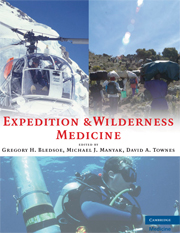Book contents
- Frontmatter
- Contents
- Contributors
- Foreword
- Preface
- Acknowledgments
- PART I EXPEDITION PLANNING
- PART II EXPEDITIONS IN UNIQUE ENVIRONMENTS
- PART III ILLNESS AND INJURIES ON EXPEDITIONS
- 24 General Medical
- 25 The Diarrhea of Travelers
- 26 Malaria: Diagnosis, Prevention, and Treatment for the Traveler
- 27 Wild Animal Attacks and Injuries
- 28 Snake and Arthropod Envenoming
- 29 Hazardous Marine Life
- 30 Expedition Toxicology
- 31 Environmental Injuries
- 32 Penetrating and Explosive Wounds
- 33 Drowning and Submersion Injury
- 34 Evaluation and Acute Resuscitation of the Trauma Patient
- 35 Principles and Practice of Expedition Wound Management
- 36 Expedition Eye Injuries and Disorders
- 37 Dental Medicine on Expedition
- 38 Foot Injuries
- 39 Expedition Orthopedics
- 40 Expedition Self-Rescue and Evacuation
- 41 Aeromedical Evacuations
- APPENDIX The Expedition Medical Kit
- Index
34 - Evaluation and Acute Resuscitation of the Trauma Patient
from PART III - ILLNESS AND INJURIES ON EXPEDITIONS
Published online by Cambridge University Press: 05 March 2013
- Frontmatter
- Contents
- Contributors
- Foreword
- Preface
- Acknowledgments
- PART I EXPEDITION PLANNING
- PART II EXPEDITIONS IN UNIQUE ENVIRONMENTS
- PART III ILLNESS AND INJURIES ON EXPEDITIONS
- 24 General Medical
- 25 The Diarrhea of Travelers
- 26 Malaria: Diagnosis, Prevention, and Treatment for the Traveler
- 27 Wild Animal Attacks and Injuries
- 28 Snake and Arthropod Envenoming
- 29 Hazardous Marine Life
- 30 Expedition Toxicology
- 31 Environmental Injuries
- 32 Penetrating and Explosive Wounds
- 33 Drowning and Submersion Injury
- 34 Evaluation and Acute Resuscitation of the Trauma Patient
- 35 Principles and Practice of Expedition Wound Management
- 36 Expedition Eye Injuries and Disorders
- 37 Dental Medicine on Expedition
- 38 Foot Injuries
- 39 Expedition Orthopedics
- 40 Expedition Self-Rescue and Evacuation
- 41 Aeromedical Evacuations
- APPENDIX The Expedition Medical Kit
- Index
Summary
INTRODUCTION
Trauma is a common disease worldwide. Injuries account for over five million deaths per year across the world. Trauma is the leading cause of death in patients aged 1–44 in the United States. All patients require immediate evaluation and resuscitation to prevent mortality and morbidity after trauma. Trauma centers dedicated to the care of these injured patients are promoted as models to improve care overall and have been documented to have done so in developed nations. However, basic initial management has the potential to save more lives globally than the advanced care at specialized centers.
The Advanced Trauma Life Support (ATLS) course sponsored by the American College of Surgeons is the gold standard for teaching initial trauma management and evaluation. The course began in the 1970s in the United States and has since spread around the globe. It clearly emphasizes the importance of the initial resuscitation. ATLS is taught based on the premise that the student may be the only physician treating an injured patient in a small rural hospital. Although not initially designed to do so, this major premise is easily extrapolated to trauma in remote and extreme environments. Although not all diagnostic tools and therapeutic options will be available, the same emphasis on the primary and secondary surveys, therapeutic adjuncts, and a plan for transfer (or evacuation) apply to austere environments. Improvisation and thinking on one's feet are clearly important tools for management of trauma in a nonhospital setting.
- Type
- Chapter
- Information
- Expedition and Wilderness Medicine , pp. 529 - 543Publisher: Cambridge University PressPrint publication year: 2008

